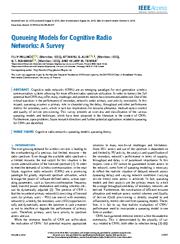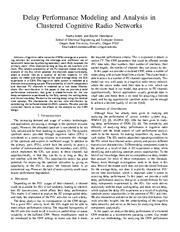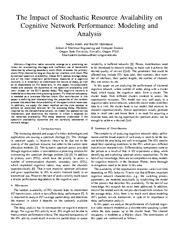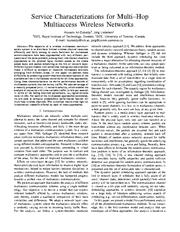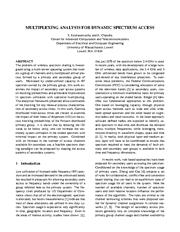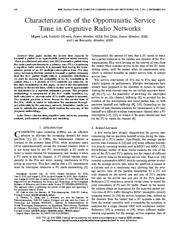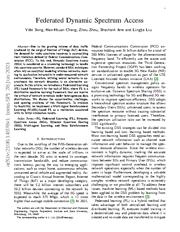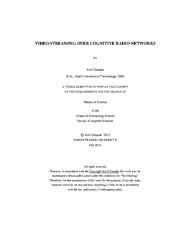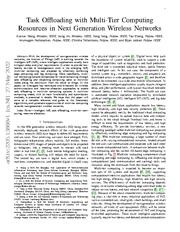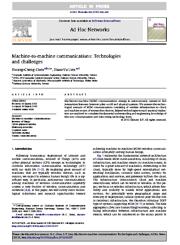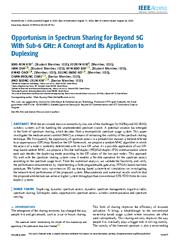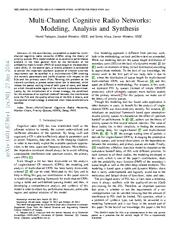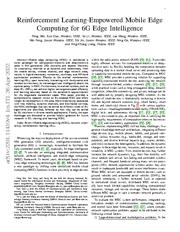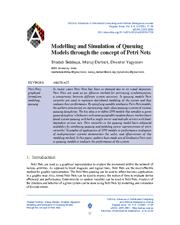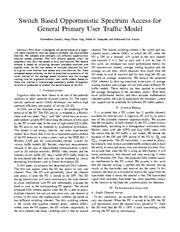A copy of this work was available on the public web and has been preserved in the Wayback Machine. The capture dates from 2020; you can also visit the original URL.
The file type is application/pdf.
Filters
Queueing Models for Cognitive Radio Networks: A Survey
2018
IEEE Access
He has authored two books Queueing Theory for Telecommunications: Discrete Time Modelling of a Single Node System (Springer, 2010) and Applied Discrete-Time Queues (Springer, 2015). ...
Cognitive radio networks (CRNs) are an emerging paradigm for next generation wireless communication systems allowing for more efficient radio spectrum utilization. ...
While continuous-time analysis allows for the characterization of the queueing system at any instant of time, discrete-time analysis gives the system state only at discrete time points. ...
doi:10.1109/access.2018.2867034
fatcat:wmj5v3eppzc2hcdwx4xnqn55ue
Delay performance modeling and analysis in clustered cognitive radio networks
2014
2014 IEEE Global Communications Conference
In this paper, we model and characterize the total average delay the SUs experience in a CRN. The cognitive radio system is modeled as a discrete-time queueing system. ...
The random availability of the PU channels makes the delay analysis of the SU, which accesses the channels opportunistically, plays a crucial role as a quality of service measure. ...
This opportunistic access has great potentials for improving the spectrum utilization by giving an opportunity to the SUs to access the licensed bands in an economical way. ...
doi:10.1109/glocom.2014.7036806
dblp:conf/globecom/AdemH14
fatcat:zyx3oh7pcndybnz76h6gmsjbae
The impact of stochastic resource availability on cognitive network performance: modeling and analysis
2015
Wireless Communications and Mobile Computing
The cognitive network is modeled as a discrete-time queueing system. PU channel occupancy is modeled as a two-state Markov chain. ...
Cognitive radio networks emerge as a promising solution for overcoming shortage and inefficient use of bandwidth resources by allowing secondary users (SUs) to access the primary users (PUs) channel so ...
There are L clusters, each contend with probability P c to access the spectrum. Each cluster is modeled as a discrete-time queueing system where the data queues up at the cluster head buffer. ...
doi:10.1002/wcm.2640
fatcat:i63ty7ypgnec5cle7qfkm33dnm
Service characterizations for multi-Hop multiaccess wireless networks
2014
2014 IEEE Conference on Computer Communications Workshops (INFOCOM WKSHPS)
For each of the multiaccess approaches considered, we are able to compute probabilistic performance bounds for multi-hop wireless channels. ...
Different system models with sometimes incongruent assumptions make it difficult to compare or reconcile multiaccess solutions emerging from different areas. ...
The analysis uses a fluid-flow traffic model and a discrete time domain with equally sized time slots. We further assume that the system starts with empty queues at t = 0. ...
doi:10.1109/infcomw.2014.6849334
dblp:conf/infocom/Al-ZubaidyL14
fatcat:kvuh4hcdznew3ojph466ojfctm
Multiplexing Analysis for Dynamic Spectrum Access
2006
MILCOM 2006
The problem of wireless spectrum sharing is investigated using a multi-server queueing system that models a group of channels and a multiplexed arrival process formed by a primary and secondary group of ...
Combined with an increase in the number of excess channels available for secondary use, a feasible spectrum sharing paradigm can be proposed by shaping the access patterns of secondary systems. ...
The multi-server queueing model of a channel bank that admits primary and secondary access is described in Section 2. ...
doi:10.1109/milcom.2006.302193
fatcat:zxjkepx7ingtrmhuuzdfd3k72e
Characterization of the Opportunistic Service Time in Cognitive Radio Networks
2016
IEEE Transactions on Cognitive Communications and Networking
This paper studies the service time required to transmit a packet in an opportunistic spectrum access scenario, where an unlicensed secondary user (SU) transmits a packet using the radio spectrum licensed ...
Our analysis provides a lower bound for the service time of the SUs, which is useful to determine the maximum throughput achievable by the secondary network. ...
[16] consider a preemptive M/G/1 priority queueing system to evaluate the average service time when the spectrum is sensed in a discrete and in a continuous way, showing that the average service time ...
doi:10.1109/tccn.2016.2603994
fatcat:6m746ssuhnei3gzthd5qkwkkqi
Federated Dynamic Spectrum Access
[article]
2021
arXiv
pre-print
To this end, Dynamic Spectrum Access (DSA) is considered as a promising technology to handle this spectrum scarcity. ...
To evaluate its feasibility, we implement a Multi-Agent Reinforcement Learning (MARL)-based FL as a realization associated with its initial evaluation results. ...
We model a SUs spectrum accessing strategy to utilize the spectrum resources efficiently in CBRS system. ...
arXiv:2106.14976v1
fatcat:qujegdwopfdwvebzvnqiqlxnzy
Video streaming over cognitive radio networks
2012
Proceedings of the 4th Workshop on Mobile Video - MoVid '12
As a result, cognitive radio emerged as a new paradigm to address the spectrum underutilization problem by enabling users to opportunistically access unused spectrum bands. ...
In our framework, we introduce a channel usage model based on a two-state Markov model and estimate the future busy and idle durations of the spectrum based on past observations. ...
Hidden Markov Model According to the definition by [13] , a hidden Markov process (HMP) is a discrete-time finite state homogeneous Markov chain observed through a discrete-time memoryless invariant channel ...
doi:10.1145/2151677.2151685
fatcat:jqklvpfl2bgmrk3xzjqudvlpuy
Task Offloading with Multi-Tier Computing Resources in Next Generation Wireless Networks
[article]
2022
arXiv
pre-print
A multi-tier computing model, with its main functionality and optimization methods, is presented in details. ...
More specifically, multi-tier computing systems compensate for cloud computing through task offloading and dispersing computing tasks to multi-tier nodes along the continuum from the cloud to things. ...
Specifically, when the time step size approaches zero, the optimization algorithm for discrete time system is similar to the continuous time system. ...
arXiv:2205.13866v1
fatcat:kt7zx34yljfejnxoqo3zjng23i
Machine-to-machine communications: Technologies and challenges
2014
Ad hoc networks
Machine-to-machine (M2M) communications emerge to autonomously operate to link interactions between Internet cyber world and physical systems. ...
Currently, such opportunistic nature is commonly modeled as a random process to give a general stochastic modeling for an energy harvesting communication systems as Fig. 9 , and consequently queuing model ...
Fig. 7 . 7 Phase diagram for time dynamics of CRs sharing spectrum [138] .
Fig. 8 . 8 Functional block structure of M2M systems. Statistical model(s) of energy harvesting. ...
doi:10.1016/j.adhoc.2013.03.007
fatcat:fsd6zefdq5fotbm5vhpozc4wci
Opportunism in Spectrum Sharing for Beyond 5G with Sub-6 GHz: A Concept and Its Application to Duplexing
2020
IEEE Access
This approach fits well with the spectrum sharing system since it enables a flexible operation for the spectrum access according to the spectrum usage level. ...
We first quantify the opportunity of spectrum access in a probabilistic manner, a method referred to as opportunistic (OP) map. ...
Consider a general spectrum sharing system composed of communication nodes, spectrum sensors, and a distributed server that only provides the OP value (see Fig. 1 ). ...
doi:10.1109/access.2020.3015762
fatcat:ycvr756wgrc6jnqjvxjjqfncha
Multi-Channel Cognitive Radio Networks: Modeling, Analysis and Synthesis
[article]
2014
arXiv
pre-print
In this contribution, we establish a model for multichannel cognitive radio networks (CRNs) using the theory of priority queues. ...
In the second part, a reverse problem is considered to answer the important top-down question of whether a service requirement can be satisfied in a multi-channel CRN knowing the network parameters and ...
Here, N channels (say servers) represent portions of the spectrum that are authorized for opportunistic access by cognitive devices [27] (cf. circles in Fig. 1 ). ...
arXiv:1401.6736v1
fatcat:chwc3ghv5fhnvdg4zcdzoum3hi
Reinforcement Learning-Empowered Mobile Edge Computing for 6G Edge Intelligence
[article]
2022
arXiv
pre-print
This paper provides a comprehensive research review on RL-enabled MEC and offers insight for development in this area. ...
Mobile edge computing (MEC) is considered a novel paradigm for computation-intensive and delay-sensitive tasks in fifth generation (5G) networks and beyond. ...
For a large number of random mobile tasks, the major question is how to orchestrate unlicensed spectrum resources and coordinate time-varying channel access for communication-efficient task execution in ...
arXiv:2201.11410v4
fatcat:24igkq4kbrb2pjzwf3mf3n7qtq
Modelling and Simulation of Queuing Models through the concept of Petri Nets
2020
Advances in Distributed Computing and Artificial Intelligence Journal
Authors have find system queuing with both a single server and multiple servers with load-dependent service rate. ...
Petri Nets are used as an effective method for portraying synchronization, a concurrency between different system activities. ...
For modeling and study of spectrum occupancy in CR networks, authors used a single server retrial queueing method with preemptive priority. ...
doaj:84777949d16d47a08578f421954872c9
fatcat:d6uzhwnpj5f2zjh73e2vhl2i4i
Switch Based Opportunistic Spectrum Access for General Primary User Traffic Model
2012
IEEE Wireless Communications Letters
For these proposed access schemes, we derive analytical expressions of the novel metrics of the average access duration and the average waiting time for a general primary user traffic model. ...
Based on these two metrics a time-average secondary access throughput formula is presented to predict the performance of the SU. ...
SYSTEM MODEL It is assumed that a PU system has L parallel channels available for transmission. A cognitive SU will try to access one of the available channels opportunistically. ...
doi:10.1109/wcl.2012.061212.120311
fatcat:ehvnm4jdz5bxnczkppu3wqxxne
« Previous
Showing results 1 — 15 out of 1,737 results

